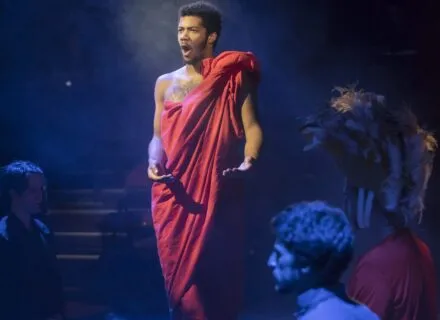
What to expect-
Through our program each student will gain a true mentorship experience that combines classroom lectures and training alongside the many hours of actual hands-on practical opportunities. Inside the walls of the expansive Krannert Center for the Performing Arts, you will be working with the latest technology in lighting systems and fixtures including various LED and moving lights. Within each of our venues, students will get to work on various shows including theatre, musical theatre, dance, and opera where we have a unique partnership with Illinois Theatre, Dance at Illinois, and the School of Music’s opera program, Lyric Theatre. Students also will be immersed in an environment of shows with opportunities to work side by side with other students and faculty, guest directors and professional designers from New York, Chicago, and beyond.

How We Teach and What You Learn
How We Teach and What You Learn
As continuing professional lighting designers ourselves, having worked On-Broadway, Off-Broadway, and in many of the top regional theatres across the country, we bring to the classroom current knowledge of the art of lighting design, which includes up-to-date technologies in terms of equipment trends, including the latest in LED technology, control consoles, and dimming systems. As faculty members and advisors our jobs do not stop in the classroom. We have a strong mentoring system set in place for every production we do within the walls of the Krannert Center and beyond. Throughout the entire design, tech, and dress rehearsal process, we are right there beside you making sure that each show has a healthy and productive process for the entire team.
Within the classroom students will gain knowledge in all aspects of lighting design including studying the qualities of light (intensity, color, distribution, and movement), electricity and lighting systems, Vectorworks Spotlight computer-aided drafting software, Lightwright software, script analysis, cueing techniques, trouble shooting, problem solving, collaboration, and advanced color theory, just to name a few. By the end of your residency here as a student, it is our goal to have you ready to compete with other designers in the entertainment industry. We also take great pride in fine-tuning each of our student’s resumes and portfolios in order to get ready for the many design competitions and conferences that we recommend that every student attend.
The Classroom as Lighting Laboratory
The Classroom as Lighting Laboratory
In order for our students to gain the knowledge necessary to design in any of our three main stage venues in addition to the Armory Theatre, we have created two lighting laboratories within the Digital Media Design Lab. The larger of the two labs uses the same lighting technology and fixtures as would be available in our actual theatres. It consists of approximately 40–50 lighting fixtures and (24) 2.4kw ETC dimmers. This lab is primarily used as a place to recreate scenes from various theatrical pieces which gives students the opportunity to experiment with color, texture, angle, and cueing. The smaller of the two labs is the 6:1 Scale Mini Light Lab, which gives the students more opportunities to experiment with color, texture, and cueing, in addition to being able to light actual scenic models for presentation and learning purposes. This lab is also equipped with (24) 600w dimmers, (12) mini ERS fixtures, (12) MR-16 Pars, (8) 3-1/2” Fresnels, (5) moving mirrored lights, and various LED cyc wash fixtures.
The Designer and the Technician
You will get to work on countless shows in various positions including Lighting Designer, Assistant Lighting Designer, Master Electrician, Assistant Master Electrician, Electrician, Light Board Programmer, and Follow Spot Operator. On many occasions, we have also allowed our lighting students to serve as Projection Designers depending on the needs of each production.
The Master of Fine Arts Program
Every MFA candidate in Lighting Design must be in residency for six semesters and will most likely be rewarded a Lighting Assistantship to cover the majority of tuition costs. It is our goal to give each student an opportunity to design in each of our three main stage venues including the 979-seat Tryon Festival Theatre, the 678-seat Colwell Playhouse, or the flexible 200-seat/max Studio Theatre black box space. Because of the large number of shows we produce each year, every MFA Lighting Design candidate will design between 4–6 main stage shows while they are in residence.
MFA Lighting Design Curriculum
For further information about any of our lighting design programs, contact Brant Murray.